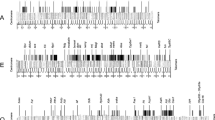Abstract
Probes specific to chromosome elements were used to investigate chromosome homologies between seven species of the Drosophila obscura group by in situ hybridization. Our results were in perfect agreement with the already established chromosome element homologies between D. subobscura, D. pseudoobscura, D. persimilis, and D. miranda. Furthermore, we were able to identify the chromosomal elements of D. obscura, D. ambigua, and D. subsilvestris. Of special interest was the localization of the two D. melanogaster-derived representatives of the tandemly repetitive genes, cDm500 and 12D8. In contrast to the findings with the element-specific probes, the localizations of the repetitive genes varied in the various species. Whereas D. melanogaster, D. subobscura, D. pseudoobscura, D. persimilis, and D. miranda showed only one strong block of label in the cross in situ hybridizations with cDm500, three labeling blocks were found on two elements for both D. ambigua and D. obscura. The two labeling blocks on one element occur in very close proximity, but are clearly separated in both species by cytologically detectable chromosomal material. We used the distribution of the cDm500 labeling sites to postulate a series of chromosomal rearrangements involved in the karyotype evolution of the analyzed species. Our results support the conclusion that the chromosomal elements retain their essential identity and that the observed gross structural rearrangements are due to fusions and paracentric or pericentric inversions. Cytologically obvious translocations were not recorded and are considered by us to be rare. The frequently occurring translocations of the tandemly repeated gene clusters observed in this study are probably due to a different mechanism, which may be an intrinsic property of this category of genes.
Similar content being viewed by others
References
Artavanis-Tsakonas S, Schedl P, Tschudi C, Pirotta V, Steward R, Gehring WJ (1977) The 5S genes of Drosophila melanogaster. Cell 12:1057–1067
Buzzati-Traverso AA, Scossirolli RE (1955) The “obscura” group of the genus Drosophila. Adv Genet 7:47–92
Dobzhansky Th, Tan CC (1936) Studies on hybrid sterility III. Z Vererbungsl 72:88–114
Goldberg ML, Paro R, Gehring WJ (1982) Molecular cloning of the white locus region of Drosophila melanogaster using a large transposable element. EMBO J 1:93–98
Lakovaara S, Keränen L (1980) Phylogeny of the Drosophila obscura group. Genetika 12:157–172
Lakovaara S, Saura A (1983) Evolution and speciation in the Drosophila obscura group. In: Ashburner M, Carson HL, Thomson JN (eds) The genetics and biology of Drosophila, vol 3 b. Academic Press, London, pp 2–59
Lifton RP, Goldberg ML, Karp RW, Hogness DS (1978) The organization of the histone genes in Drosophila melanogaster: Functional and evolutionary implications. Cold Spring Harbor Symp Quant Biol 42:1047–1051
Loukas M, Krimbas CB, Mavragani-Tsipidou P, Kastritsis CD (1979) Genetics of Drosophila subobscura populations. VII. Allozyme loci and their chromosome maps. J Hered 70:17–26
Mainx F, Koske Th, Smital E (1953) Untersuchungen über die chromosomale Struktur europäischer Vertreter der Drosophila obscura Gruppe. Z Vererbungsl 85:354–372
Muller HJ (1940) Bearings of the Drosophila work on systematics. In: Huxley J (ed) The new systematics. Oxford University Press, pp 185–268
Patterson JT, Stone WS (1952) Evolution in the genus Drosophila. MacMillan Company, New York
Pinsker W, Sperlich D (1984) Cytogenetic mapping of enzyme loci on chromosome J and U of Drosophila subobscura. Genetics (in press)
Schweizer-Hess C (1979) Localization of histone genes and nucleolus organizing regions in the polytene and mitotic karyotypes of Drosophila affinis and Drosophila subobscura. Thesis, Universität Zürich
Steinemann M (1982a) Multiple sex chromosomes in Drosophila miranda: A system to study the degeneration of a chromosome. Chromosoma 86:59–76
Steinemann M (1982b) Analysis of chromosomal homologies between two species of the subgenus Sophophora: D. miranda and D. melanogaster using cloned DNA segments. Chromosoma 87:77–88
Steinemann M (1984) Telomere repeats within the neo-Y chromosome of Drosophila miranda. Chromosoma 90:1–5
Sturtevant AH, Novitski E (1941) The homologies of the chromosome elements in the genus Drosophila. Genetics 26:517–541
Tan CC (1935) Salivary gland chromosomes of the two races of Drosophila pseudoobscura. Genetics 20:392–402
Tan CC (1937) The cytological maps of the autosomes in Drosophila pseudoobscura. Z Zellforsch Mikrosk Anat 26:439–461
Author information
Authors and Affiliations
Additional information
This paper is dedicated to Prof. Hans Bauer on the occasion of his 80th birthday with our best wishes
Rights and permissions
About this article
Cite this article
Steinemann, M., Pinsker, W. & Sperlich, D. Chromosome homologies within the Drosophila obscura group probed by in situ hybridization. Chromosoma 91, 46–53 (1984). https://doi.org/10.1007/BF00286484
Received:
Issue Date:
DOI: https://doi.org/10.1007/BF00286484




